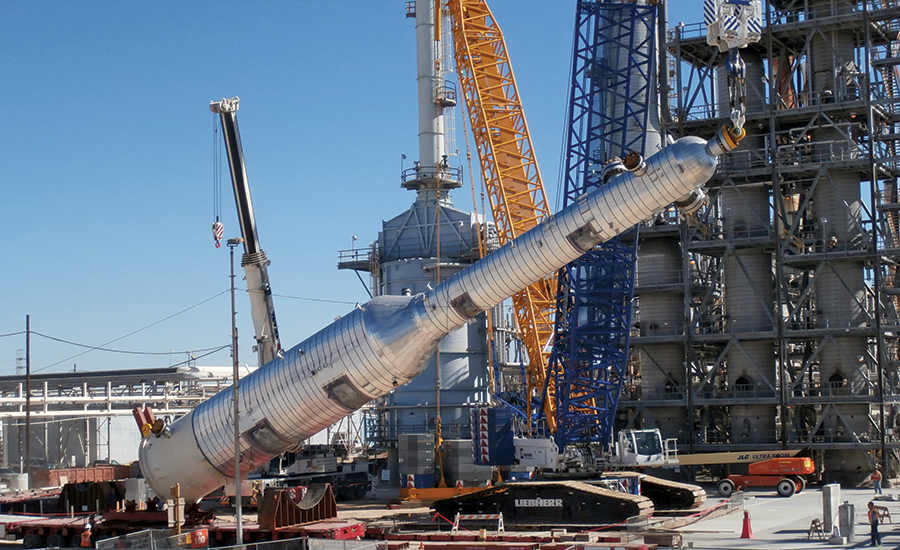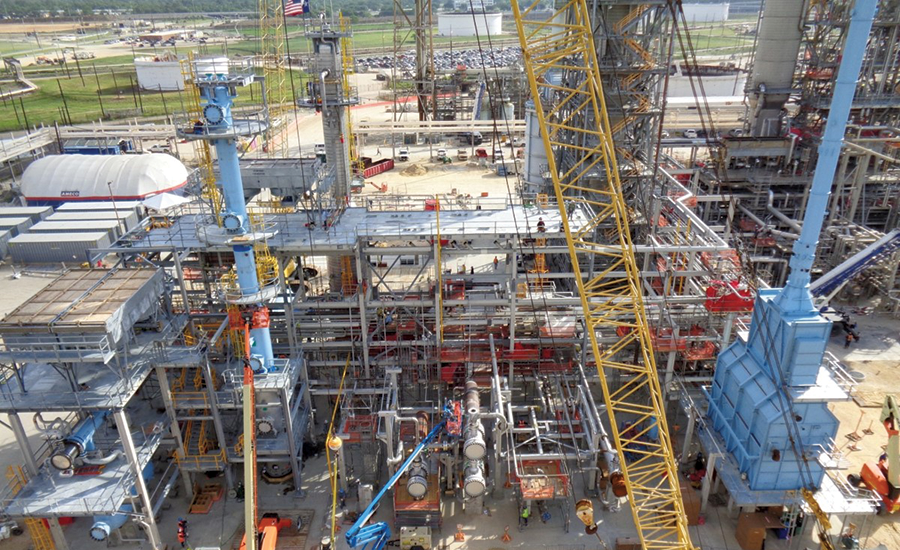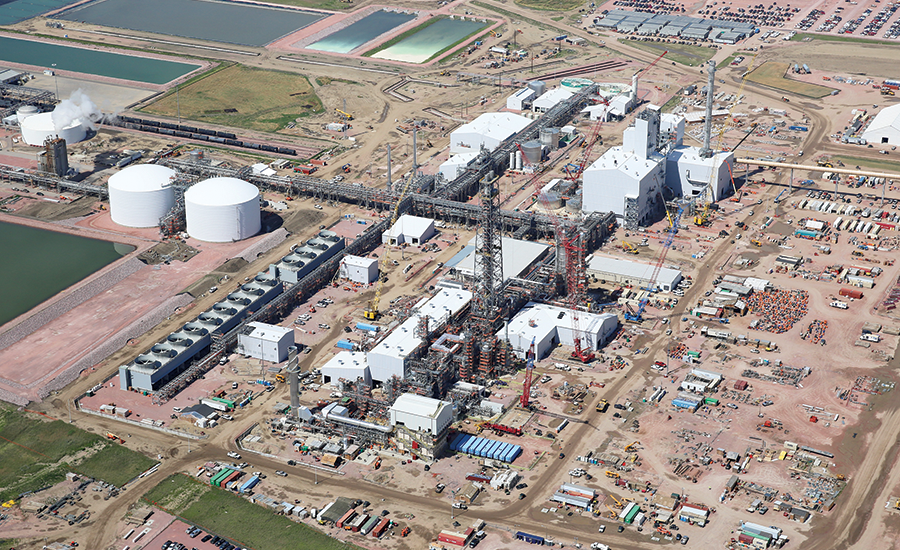Strong Investment in People Drives La. Firm's Success
Performance Contractors recognized for strong regional growth and its commitment to training and staff development

Performance Contractors’ corporate office is located in Baton Rouge.
PHOTO COURTESY OF PERFORMANCE CONTRACTORS

Performance Contractors conducts work on a confidential project along the Texas Gulf Coast.
PHOTO COURTESY OF PERFORMANCE CONTRACTORS

The company typically has an average of 150 projects ongoing at any given time throughout the year.
PHOTO COURTESY OF PERFORMANCE CONTRACTORS

Construction of new ammonia, urea synthesis and urea granulation plants for CF Industries in Sergeant Bluff, Iowa.
PHOTO COURTESY OF CF INDUSTRIES




Over the last three years, Baton Rouge-based Performance Contractors has steadily climbed up ENR Texas & Louisiana’s annual Top Contractors ranking, going from 19th in 2014 to 14th in 2015 and now up to No. 8 in 2016.
Specializing in industrial work, the company posted revenue of $866 million in 2015, an increase of $264 million over the prior year.
Plentiful work in the energy and industrial markets has spurred the company’s strong growth in the past year. Performance does a variety of construction, turnaround and maintenance services for the automotive, chemical, fertilizer, petrochemical, pulp and paper, power, refinery and steel industries.
The firm also has renewed its focus on developing and retaining a skilled workforce. Performance has 9,000 employees, with 6,500 of those in the region.
In addition to its offices across Louisiana, the firm has locations in Texas, Mississippi, Alabama and Iowa.
ENR Texas & Louisiana has chosen Performance Contractors as its 2016 Contractor of the Year. The firm’s sizable project portfolio, regional growth and commitment to developing and retaining its people have earned it respect across the region.
Article Index:
Building Success
The gains of the past several years arose for several reasons, some planned and some the result of being in the right place at the right time, says Art Favre, president and owner of Performance. “A lot of the larger projects that were announced several years ago have just now started coming into fruition in terms of the field activity,” he says.
Performance took advantage of increased activity in the industrial arena during 2015 and into 2016. Two major projects in the region with total costs estimated at around $1 billion or more contributed to the company’s growth—ExxonMobil’s expansion project in Mont Belvieu, Texas, and Dow Chemical’s Poly B and Poly D projects in Plaquemine, La.
A third major project, CF Industries’ new $2-billion nitrogen facility in Port Neal, Iowa, grew the firm’s portfolio outside the South. Those three projects are the company’s largest jobs at the moment.
More work during 2015, plus “the fact that we had really concentrated on trying to increase our market share in our primary work areas, which is the Gulf Coast region from Texas all the way to Florida,” all played a significant role in boosting Performance’s revenue, Favre says.
The company typically averages about 150 jobs at a time, notes Lee Jenkins, vice president at Performance. “We completed about 230 projects in 2015. We have jobs of incredible diversity in size,” he explains. “We want to be involved and be competitive on jobs of all sizes, and all of them are important.”
In response to the increasing number of projects and market opportunities, the company also doubled its pipe-fabrication capabilities, with up to 240,000 sq ft of prefab shops in Alabama, Louisiana and Texas.
All About People
Performance’s employee retention and development is a major focus for the company. “If you think about a construction company, we’re a service organization. The only thing we really have to sell is the quality of our people, so the amount of time we put into training those people and making those people better team members and better performers, the better our company becomes,” Favre explains.
Performance has broadened its knowledge base and now has experts on “just about any phase of construction that you can think of,” he notes. That expertise is shared across projects as needed, giving the firm a competitive advantage, Favre says.
“Our strategy in terms of success on a job is centered on the ability to man with known resources,” Jenkins adds. “We want to make sure we have the ability to base-load a project with known resources from the craft level through the leadership ranks to ensure that we bring the Performance culture and way of doing business to every project.”
The company implemented several programs years ago to develop young supervisory talent and support skills for its people, Favre says.
One of those programs is Build America Careers, which focuses on supervision and sponsorship of craft training by those at the foremen levels and above, explains Jenkins.
Performance also has partnered with Louisiana State University on several training grants to build and develop leadership-training programs. The company also sponsors high school craft training as well. Since the early 1990s, Performance has “adopted” high schools and community colleges to participate in training classes such as welding, mechanics and other skills, Jenkins says. The ultimate goal is to get students interested in the industry by attracting them to these courses.
“We have currently adopted 54 high schools and 40 community colleges throughout the Gulf Coast,” he says.
Many of Performance’s workers are long-term employees, notes Mike White, senior vice president, operations for TPC Group, a Houston-based chemical manufacturing firm. Performance was the primary mechanical contractor on a project for TPC that refurbished a butane dehydrator unit in Houston in 2014.
The positive attitudes and “calm sense of urgency” with which Performance’s teams worked greatly benefited the project, White says. “They really worked with us extremely well and under some difficult circumstances, and their safety was exemplary.”
Safety First
In 2015, Performance’s teams clocked more than 16 million man-hours, with a TRIR of 0.27 and an EMR of 0.67.
“We’ve always had a strong emphasis on safety, but we’ve really reinforced that in the last couple years,” Favre says. To do that, Performance creates a safety culture on the jobsite, he explains.
“It’s really been more of a mental process, if you will, with the workforce, rather than here’s another rule to follow,” Favre adds.
The firm has developed a video training program that plays a growing role in its overall safety program. “We have videographers that film and produce videos utilizing Performance employees in the field to present various training topics throughout our company,” Jenkins says. “The energy is that it isn’t some formal trainer who’s standing up in front of a classroom; it’s our people in the field wearing safety gear.”
The company also is adopting hands-on evaluations of the craft skills for new hires who may not have a proven training record with the Associated Builders and Contractors or the National Center for Construction Education and Research, or those who do not have a certificate or diploma based on formal training.
“This is in addition to the written testing that we already do,” Jenkins says. “What we’re trying to minimize is someone who is on the jobsite that doesn’t have the necessary, verifiable skill level.”
This focus on safety is part of what makes Performance successful, says Valero Energy Corp.’s Eric Honeyman.
“Despite being a large company, they have the feel of a strong family and a good neighbor,” he explains. “Our employees enjoy working with them side by side, and as a trusted partner, the line between company and contractor is transparent.”
Honeyman says this collaboration leads to “great safety performance and predictable results, both of which are critical to Valero’s business objectives,” he says. “They have been particularly successful in adapting to our changing schedules and support needs without any loss in quality or service.”
In the last five years, Performance has completed about $100 million in industrial work for Valero and turnaround work at seven locations.
Looking Ahead
Throughout its 36 years in operation, Performance has remained a privately owned and operated company. “We have been incredibly sensitive to maintaining our culture and identity throughout this growth,” Jenkins notes. “We want to be the same company on a small job in a rural location as we are on a big megajob in the industrial center of Houston.”
While the number of megajobs has declined along the industrial Gulf Coast, where the majority of the firm’s work is located, there are still plenty of projects out there, Jenkins says. Both 2016 and 2017 are shaping up to be positive years.
“I think it’s going to be a bit more challenging to grow at the pace that we’ve grown, so holding our own will be more of an accomplishment than growth in the ’17, ’18, ’19 time frame,” Favre says. “But that’s something that could change too—our market changes almost daily.”








